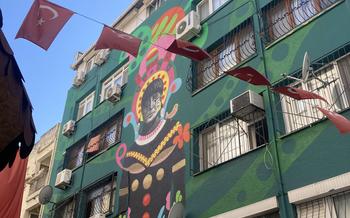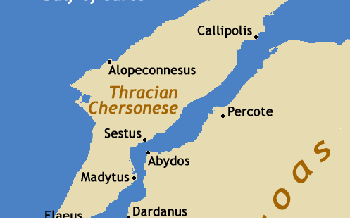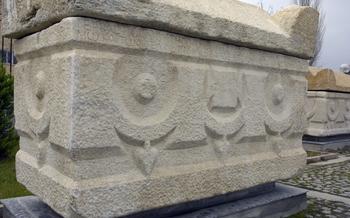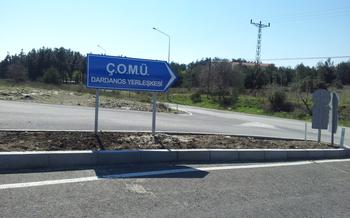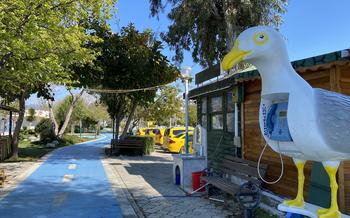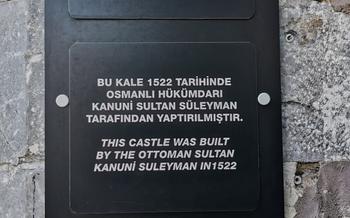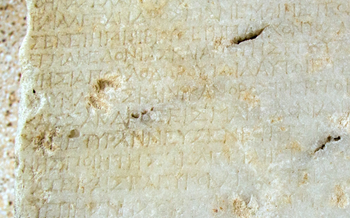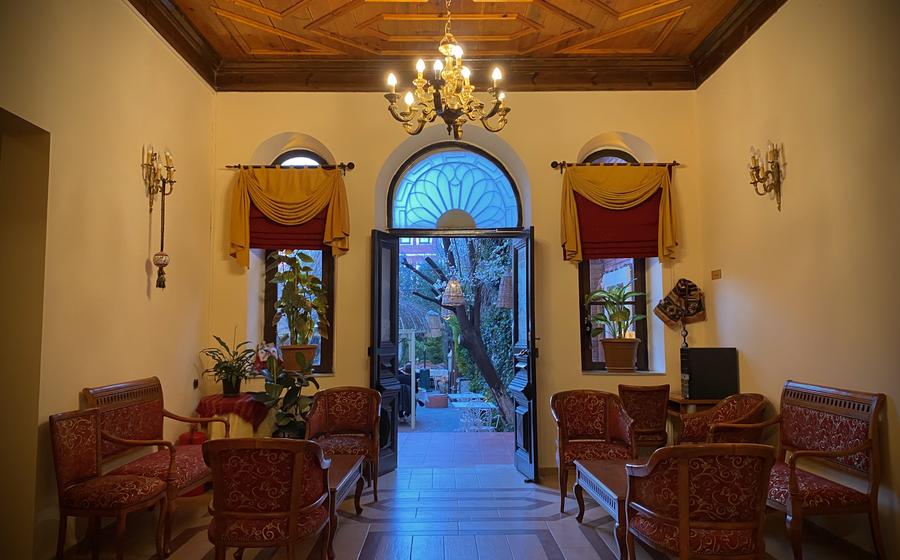
Apollon Smintheion Sacred Area
- History of the Apollon Smintheion Sacred Area
- Location and Getting There
- Archaeological Excavations
- The Temple of Apollo Smintheus
- The Sacred Precinct
- The Oracle of Apollo Smintheus
- The City of Chryse
- The Museum of Çanakkale
- Accommodation and Dining Options
- Guided Tours and Itineraries
- Photography and Videography
- Events and Festivals
- Insider Tip
- Accessibility and Facilities
- Sustainable Tourism Practices
- Insider Tip: Unveiling the Hidden Gem of Gülpınar Waterfall
History of the Apollon Smintheion Sacred Area
The Apollon Smintheion Sacred Area, located in the ancient city of Chryse, holds a significant place in Greek mythology and history. The name "Smintheion" originates from the Greek word "sminthos," meaning "mouse," and is associated with Apollo's role as the protector of fields and crops from mice and other pests.
The site's historical and cultural significance stems from its association with Apollo, one of the most revered gods in the Greek pantheon. Apollo was worshipped as the god of prophecy, music, healing, and the sun. The Apollon Smintheion was a major religious center where people from across the ancient world sought advice and guidance from Apollo's oracle.
The oracle at the Apollon Smintheion was renowned for its accuracy and influence. People from all walks of life, including kings, generals, and ordinary citizens, consulted the oracle to seek guidance on important decisions. The priests of Apollo would interpret the god's messages through various methods, such as observing the flight of birds or examining the entrails of sacrificed animals.
According to legend, Apollo Smintheus was particularly revered in the city of Chryse. When the city was besieged by an army of mice, Apollo intervened and saved the city by sending a plague of snakes to devour the rodents. In gratitude, the people of Chryse built a magnificent temple dedicated to Apollo Smintheus, which became the focal point of the Apollon Smintheion Sacred Area.
Location and Getting There
The Apollon Smintheion Sacred Area is located in the northwestern part of Turkey, in the province of Çanakkale. It lies approximately 15 kilometers southwest of the city of Çanakkale, near the village of Gülpınar. The site is situated on a hilltop overlooking the Dardanelles Strait, offering breathtaking views of the surrounding landscape.
To get to the Apollon Smintheion Sacred Area, you can take a bus or rent a car from Çanakkale. The journey by bus takes around 30 minutes and costs approximately 5 Turkish lira. If you prefer to drive, the journey takes about 20 minutes and there is a parking lot available near the site.
Organized tours are also available from Çanakkale, which typically include transportation to and from the site, as well as a guided tour of the ruins. These tours are a great option for those who want to learn more about the history and significance of the site.
If you are self-driving, be aware that the roads leading to the Apollon Smintheion Sacred Area are narrow and winding. It is advisable to drive slowly and carefully, especially during peak tourist season.
Archaeological Excavations
The Apollon Smintheion Sacred Area has been the subject of extensive archaeological excavations since the late 19th century. The first major excavations were conducted by the French archaeologist Charles Champoiseau in 1881-188Champoiseau's work uncovered the remains of the Temple of Apollo Smintheus and several other structures within the sacred precinct.
In the 1950s, Turkish archaeologists resumed excavations at the site under the direction of Ekrem Akurgal. Akurgal's team expanded the scope of the excavations, uncovering additional structures and artifacts. They also discovered the remains of the ancient city of Chryse, which was located near the sacred area.
Excavations have continued at the Apollon Smintheion Sacred Area in recent years, led by a team of Turkish and international archaeologists. These excavations have yielded important new insights into the history and significance of the site. Among the most important discoveries are the remains of a large altar, which was used for animal sacrifices, and a number of inscriptions that provide valuable information about the oracle and its rituals.
Despite the progress that has been made, much of the Apollon Smintheion Sacred Area remains unexcavated. The ongoing excavations are providing valuable new information about this important site and its role in the religious life of the ancient Greeks.
The Temple of Apollo Smintheus
The Temple of Apollo Smintheus stands as a testament to the architectural prowess and religious devotion of the ancient Greeks. Constructed in the 5th century BC, the temple exhibits a harmonious blend of Doric and Ionic architectural elements, showcasing the transition between these two influential styles. Its well-preserved ruins allow visitors to admire the intricate details and grandeur of this once-sacred structure.
The temple's design is characterized by its rectangular shape, surrounded by a colonnade of Doric columns. The cella, or inner chamber, housed the cult statue of Apollo Smintheus, crafted from gold and ivory by the renowned sculptor Kanachos of Sikyon. The statue, revered for its beauty and craftsmanship, is sadly lost to time, but its fame lives on through historical accounts.
As a religious center, the Temple of Apollo Smintheus served as a place of worship, offerings, and oracles. Devotees sought divine guidance and prophecies from the oracle, who was believed to channel the wisdom of Apollo Smintheus. The rituals performed within the temple were elaborate and solemn, reflecting the deep reverence for the deity.
The temple's history is not without its challenges. It has endured several earthquakes and natural disasters, leaving visible marks of its resilience. Restoration efforts have been ongoing to preserve and protect this ancient treasure, ensuring its legacy continues to inspire and captivate visitors for generations to come.
The Sacred Precinct
The sacred precinct of the Apollon Smintheion was an extensive and well-organized space dedicated to religious practices and rituals. Surrounding the Temple of Apollo Smintheus, it encompassed various structures and monuments that played significant roles in the religious life of the ancient Greeks.
Within the precinct, visitors would find altars for sacrifices and libations, as well as smaller temples and shrines dedicated to other deities associated with Apollo. These structures served as places of worship and devotion for the local population and pilgrims who traveled from afar to seek the oracle's guidance and pay homage to the gods.
One of the most notable features of the precinct was the stoa, a long, covered walkway that provided shelter from the sun and rain. The stoa was adorned with columns and benches, creating a serene and contemplative atmosphere for religious activities and gatherings.
Another essential structure within the precinct was the bouleuterion, a council chamber where the city's leaders and officials met to discuss important matters and make decisions. This building served as a hub for civic and religious governance, reflecting the close relationship between politics and religion in ancient Greek society.
The sacred precinct was not merely a place of worship but also a vibrant center for community gatherings and social interactions. People from all walks of life would come together to participate in festivals, celebrations, and religious ceremonies, fostering a sense of unity and belonging among the community members.
The Oracle of Apollo Smintheus
The Apollon Smintheion Sacred Area was renowned for its oracle, which played a significant role in the religious and political life of the ancient Greek world. Believers sought advice from the oracle on a wide range of matters, including personal decisions, military campaigns, and political alliances. The process of seeking guidance from the oracle involved a series of rituals and ceremonies.
Before approaching the oracle, the petitioner would undergo a period of purification and make an offering to Apollo. They would then enter the temple and pose their question to the oracle, usually in the form of a written query. The oracle's response was delivered through a priest or priestess, who would enter a trance-like state and utter cryptic prophecies.
The methods used by the oracle to deliver prophecies are still debated today. Some scholars believe that the priest or priestess would interpret signs and omens, such as the flight of birds or the rustling of leaves. Others suggest that they may have used hallucinogenic substances or engaged in forms of divination, such as scrying or dream interpretation.
The oracle of Apollo Smintheus was highly respected and influential throughout the ancient world. Its prophecies were sought by kings, generals, and statesmen from across Greece and beyond. Even the great Alexander the Great is said to have consulted the oracle before embarking on his military campaigns.
The reputation of the oracle was not always positive. Some skeptics questioned the validity of its prophecies, and there were accusations of corruption and political manipulation. Nevertheless, the oracle remained a powerful force in ancient Greek society, and its influence continued for centuries.
The City of Chryse
The ancient city of Chryse, also known as Chryseia, was a significant settlement that thrived during the Hellenistic and Roman periods. It was closely associated with the Apollon Smintheion Sacred Area and served as a religious and cultural center in the region.
According to historical accounts, Chryse was founded by the Greek colonists in the 6th century BC. It quickly became an important port city due to its strategic location on the Aegean coast. Chryse was a bustling hub of trade and commerce, with a diverse population engaged in various economic activities.
The city was renowned for its dedication to the worship of Apollo Smintheus. Numerous temples, altars, and other religious structures were built within Chryse, reflecting the deep devotion of its inhabitants to the deity. The annual festivals and ceremonies held in honor of Apollo Smintheus attracted pilgrims and visitors from across the region.
Archaeological evidence unearthed at the site of Chryse reveals the extent of its former glory. Excavations have uncovered the remains of impressive public buildings, including a theater, a gymnasium, and a market. These structures showcase the architectural prowess and urban planning of the ancient Greeks.
The ruins of Chryse stand as a testament to its rich history and cultural significance. Visitors can explore the remnants of this once-thriving city, gaining insights into the lives and beliefs of the people who inhabited this sacred landscape.
The Museum of Çanakkale
The Museum of Çanakkale is a treasure trove of artifacts and exhibits that shed light on the rich history and culture of the region. Located in the heart of the city of Çanakkale, the museum is easily accessible by foot or public transportation.
One of the highlights of the museum is its collection of artifacts related to the Apollon Smintheion Sacred Area. Visitors can admire intricate sculptures, pottery, and inscriptions that provide valuable insights into the religious practices and daily life of the ancient Greeks who inhabited this region.
In addition to the Apollon Smintheion artifacts, the museum also houses a diverse collection of exhibits covering various aspects of Çanakkale's history. From prehistoric tools to Byzantine mosaics, the museum offers a comprehensive journey through the ages.
For a deeper understanding of the Apollon Smintheion Sacred Area and its significance, visitors can join guided tours led by knowledgeable museum staff. These tours provide detailed explanations of the exhibits and help visitors connect the dots between the ancient ruins and the vibrant history of the region.
Whether you're a history buff, an archaeology enthusiast, or simply curious about the past, the Museum of Çanakkale is a must-visit destination. Its exhibits offer a fascinating glimpse into the world of the ancient Greeks and the enduring legacy of the Apollon Smintheion Sacred Area.
Accommodation and Dining Options
The Apollon Smintheion Sacred Area and the city of Çanakkale offer a variety of accommodation options for visitors. For a truly immersive experience, consider staying in one of the charming guesthouses or boutique hotels located in the heart of the ancient city. These accommodations often feature traditional Turkish architecture, warm hospitality, and stunning views of the surrounding landscape.
For those seeking a more modern and luxurious stay, several upscale hotels are situated just outside the city center. These hotels offer a range of amenities, including spacious rooms, swimming pools, and fine dining restaurants.
When it comes to dining, Çanakkale is a culinary paradise. Indulge in traditional Turkish cuisine at one of the many local restaurants, where you can savor mouthwatering dishes such as freshly grilled kebabs, succulent seafood, and aromatic mezes. For vegetarian and vegan travelers, there are several restaurants that cater to your dietary preferences.
To fully immerse yourself in the local culture, venture into the bustling markets and bazaars. Here, you'll find an array of fresh produce, spices, and handmade souvenirs. Don't miss the opportunity to sample some of the delicious street food on offer, such as gözleme (stuffed flatbread) and simit (sesame-encrusted bread).
Whether you prefer a cozy guesthouse, a luxurious hotel, or a culinary adventure, Çanakkale has something to satisfy every traveler's needs.
Guided Tours and Itineraries
Exploring the Apollon Smintheion Sacred Area with a knowledgeable guide can greatly enhance your understanding and appreciation of the site. Professional tour operators in Çanakkale offer a range of guided tours tailored to different interests and time constraints.
One popular option is a half-day tour that covers the highlights of the sacred area, including the Temple of Apollo Smintheus, the sacred precinct, and the ruins of the ancient city of Chryse. These tours typically provide historical context, point out significant architectural features, and answer any questions you may have.
For a more in-depth experience, consider booking a full-day tour that includes a visit to the Museum of Çanakkale. This allows you to delve deeper into the history and culture of the region, as well as examine artifacts excavated from the sacred area.
When selecting a tour operator, look for reputable companies with experienced guides who are passionate about the site's history. Read online reviews and compare prices to find the best fit for your needs.
To make the most of your guided tour, come prepared with comfortable shoes, sunscreen, and a hat, as the site involves a fair amount of walking and exposure to the sun. It's also a good idea to bring a camera to capture the stunning scenery and architectural details.
Whether you choose a half-day or full-day tour, exploring the Apollon Smintheion Sacred Area with a guide will provide you with valuable insights and a deeper appreciation for this ancient religious center.
Photography and Videography
The Apollon Smintheion Sacred Area offers ample opportunities for capturing stunning photographs and videos that will serve as lasting mementos of your visit. To make the most of your photographic endeavors, consider arriving at the site early in the morning or late in the afternoon when the golden hues of sunrise and sunset bathe the ruins in a warm, ethereal glow. This timing also ensures fewer crowds, allowing you to compose your shots without distractions.
When composing your photographs, experiment with different angles and perspectives to create dynamic and visually interesting images. Utilize the natural light to your advantage, allowing the sun's rays to accentuate the architectural details and textures of the ruins. If you're using a tripod, position it strategically to achieve stable and sharp shots, especially when capturing long exposures.
While drone photography is permitted at the Apollon Smintheion, it's crucial to adhere to the regulations and restrictions imposed by the authorities. Always obtain the necessary permits and operate your drone responsibly, respecting the privacy of other visitors and ensuring the safety of the site.
Remember, the Apollon Smintheion is an ancient and sacred place. Be mindful of your surroundings and avoid disturbing the serenity of the site. Respect the privacy of other visitors and refrain from taking intrusive or disrespectful photographs. By following these guidelines, you can capture beautiful memories while preserving the integrity and sanctity of this historical treasure.
Events and Festivals
The Apollon Smintheion Sacred Area comes alive during special events and festivals, offering visitors a unique opportunity to immerse themselves in the site's rich history and cultural significance. One of the most notable events is the annual Apollon Smintheios Festival, held in late summer to honor the patron deity of the site. During the festival, visitors can witness traditional Greek music and dance performances, participate in reenactments of ancient rituals, and savor delicious local cuisine.
Insider Tip
Unveiling the Hidden Sanctuary of Apollo Smintheus:
Venture beyond the main temple complex and discover the secluded Sanctuary of Apollo Smintheus, nestled amidst lush greenery. This lesser-known spot offers a tranquil retreat where you can soak in the serenity of the surroundings and connect with the sacred energy of the site. As you explore the sanctuary, keep an eye out for intricate carvings and inscriptions that provide glimpses into the ancient beliefs and practices associated with Apollo Smintheus.
Accessibility and Facilities
The Apollon Smintheion Sacred Area is committed to providing a welcoming and accessible environment for all visitors. The site features ramps and designated pathways to ensure easy navigation for individuals with disabilities. Restrooms, drinking water fountains, and seating areas are strategically placed throughout the site for the convenience of visitors. At the visitor center, knowledgeable staff is available to provide information, assistance, and guidance to all visitors. To ensure a safe and comfortable experience, follow designated trails, respect the signage, and be mindful of uneven surfaces and potential hazards. By embracing accessibility and inclusivity, the Apollon Smintheion Sacred Area strives to create a welcoming and enriching experience for all visitors, regardless of their abilities.
Sustainable Tourism Practices
The Apollon Smintheion Sacred Area is a remarkable cultural and historical treasure, and it is crucial that we all work together to protect and preserve it for future generations. Here are some simple tips for practicing sustainable tourism at the site:
-
Reduce your carbon footprint: Consider traveling to Çanakkale by bus or train instead of flying, and opt for walking or biking instead of driving whenever possible.
-
Respect the site: Stay on designated paths, avoid touching or climbing on ancient ruins, and dispose of waste responsibly.
-
Support local businesses: Choose to stay in locally-owned hotels and guesthouses, and dine at restaurants that serve traditional Turkish cuisine. This helps to support the local economy and promote cultural preservation.
-
Advocate for protection: Spread the word about the importance of the Apollon Smintheion Sacred Area and encourage others to visit and support its preservation. You can also join or donate to organizations that are working to protect the site.
By following these simple principles, we can all help to ensure that the Apollon Smintheion Sacred Area remains a source of inspiration and wonder for generations to come.
Insider Tip: Unveiling the Hidden Gem of Gülpınar Waterfall
As you explore the wonders of the Apollon Smintheion, don't miss the hidden gem that lies just a short drive away – the captivating Gülpınar Waterfall. Nestled amidst lush greenery, this natural wonder offers a serene escape from the ancient ruins. Take a leisurely stroll along the scenic path leading to the waterfall, immersing yourself in the tranquility of the surroundings. Witness the cascading waters plunge into a crystal-clear pool, creating a mesmerizing spectacle that will leave you spellbound. Pack a picnic lunch and enjoy a delightful meal amidst the tranquil ambiance of the waterfall. Remember to capture the breathtaking views with your camera and cherish the memories of this hidden gem forever.
